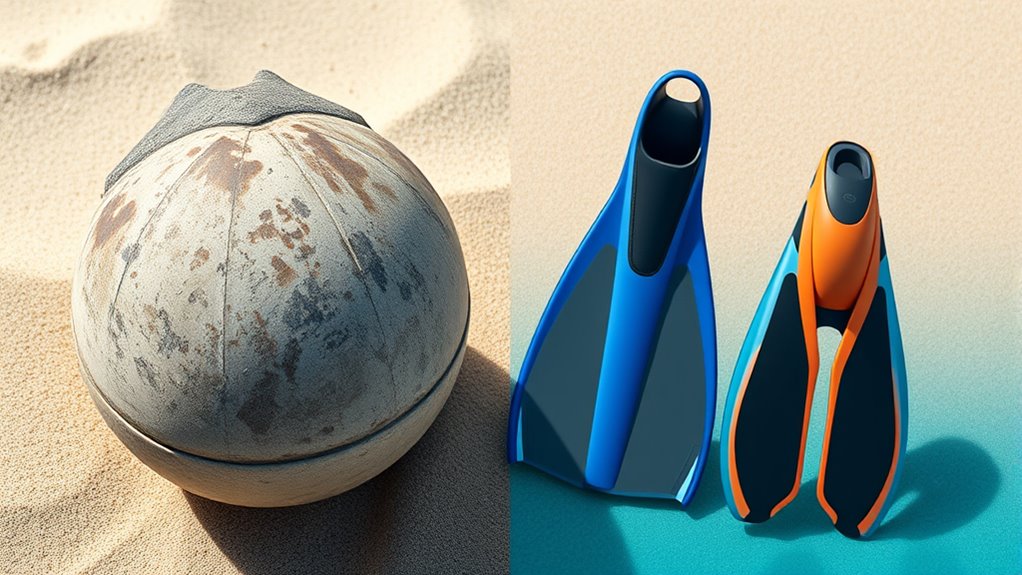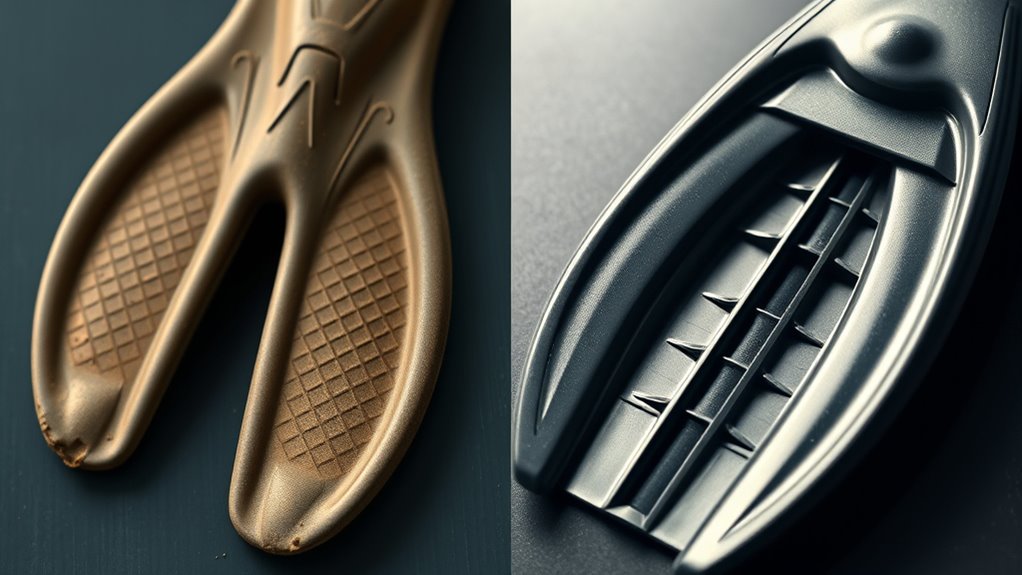The evolution of flippers shows a fascinating journey from simple, paddle-like fins on early fish to the highly specialized appendages in today’s marine creatures. Over time, fins developed bones and muscles for better control and movement in complex habitats, leading to streamlined shapes for efficient swimming. This transformation reflects natural selection’s role in adapting to aquatic environments. To learn more about how these amazing changes happened, keep exploring how different species perfected their flippers for survival.
Key Takeaways
- Early fins resembled simple paddles, gradually developing bones and muscles for better control and navigation.
- Marine flippers evolved from primitive structures, becoming specialized for speed, maneuverability, or land access.
- The internal bone structure of marine mammal flippers reflects their evolutionary link to land mammals.
- Flipper evolution demonstrates adaptation for efficient propulsion, energy conservation, and environmental survival.
- These evolutionary changes illustrate how natural selection shaped functional morphology from simple paddles to modern flippers.

The evolution of flippers showcases how aquatic creatures adapted their limbs for efficient swimming. Over millions of years, these adaptations have transformed primitive fins into highly specialized tools that maximize movement through water. You might not realize it, but every fin design you see today is a product of complex marine adaptations that offered significant evolutionary advantages. These adaptations aren’t just about speed; they improve maneuverability, stability, and energy efficiency, which are essential for survival in diverse marine environments.
Initially, the earliest aquatic animals had limb structures similar to simple paddles, providing basic propulsion. As these creatures evolved, their fins gradually became more refined, with bones and muscles developing to enhance control and power. This progression allowed them to navigate more complex habitats, hunt more effectively, and escape predators. You see, the key evolutionary advantage here is increased mobility, which directly impacts survival and reproductive success. Over time, these fins became more streamlined, reducing water resistance, and their shape shifted to optimize thrust while conserving energy.
Early fins resembled simple paddles, evolving with bones and muscles for better control and efficiency in complex habitats.
Marine adaptations also led to the development of different flipper types tailored to specific functions. For example, some marine mammals like dolphins and whales evolved elongated, paddle-shaped flippers perfect for fast swimming and precise turns. Others, like sea turtles, developed broader, more flexible flippers that facilitate both swimming and climbing onto land. These specialized designs reflect how natural selection favored structures that provided the greatest benefits in particular environments. You can appreciate how each modification improved the creature’s ability to hunt, evade predators, or migrate across vast distances—giving them a clear evolutionary advantage.
Furthermore, the internal bone structure of flippers reveals a fascinating evolutionary story. Unlike fish fins supported mainly by fin rays, many marine mammals possess limb bones similar to those of land mammals, indicating their evolutionary link to terrestrial ancestors. This connection highlights how fins are not static but are part of a broader evolutionary narrative where limbs adapted for life in water, offering stability and control. You see, these marine adaptations, such as the repositioning and reshaping of bones, were essential in enabling aquatic creatures to thrive in their environments.
In essence, the journey from simple, paddle-like fins to complex, highly specialized flippers underscores the remarkable process of evolution. Each adaptation provided an edge, whether through improved propulsion, maneuverability, or energy conservation. By understanding these marine adaptations, you gain insight into how evolution shapes life forms to meet the demands of their surroundings. The evolution of flippers isn’t just about swimming faster; it’s about survival, efficiency, and thriving in a challenging aquatic world.
Frequently Asked Questions
How Do Flipper Materials Impact Their Performance?
Your choice of flipper materials markedly impacts performance through durability and flexibility. Durable materials like rubber or silicone withstand wear and tear, ensuring long-lasting use. Flexible materials, on the other hand, allow for better movement and efficiency underwater. When selecting flippers, consider how material flexibility enhances swimming power and how durability maintains performance over time. Proper material choice helps you optimize speed, agility, and comfort during your aquatic activities.
What Are the Latest Innovations in Flipper Design?
You’ll find that the latest innovations in flipper design focus on biomechanical analysis and ergonomic improvements. Designers now optimize paddle shape and flexibility to enhance propulsion and reduce fatigue. Advanced materials and hinge mechanisms improve comfort and efficiency, allowing you to swim longer with less effort. These updates enable better water flow dynamics, making your swimming experience more effective and enjoyable while reducing strain on your muscles and joints.
How Do Flippers Evolve for Different Aquatic Environments?
You might think flippers are a one-size-fits-all tool, but marine predator adaptations reveal they actually evolve for specific environments. In fast-moving predators, streamlined flippers enhance underwater propulsion techniques, while in slow or benthic species, broader, flatter flippers provide stability and maneuverability. This evolutionary flexibility allows aquatic animals to optimize their movement, ensuring survival whether hunting in open water or steering through complex reef structures.
What Role Does Biomechanics Play in Flipper Development?
Biom biomechanics is vital in flipper development, as it shapes how marine animals adapt for efficient movement. You see, evolutionary biomechanics guides the design of flippers, optimizing them for marine adaptation by improving swimming speed, maneuverability, and energy efficiency. This scientific understanding helps explain why different species have distinct flipper shapes, showing how natural selection favors structures that enhance survival in specific aquatic environments.
How Do Ancient Flippers Compare to Modern Advanced Versions?
Ancient flipper designs are simple, paddle-like structures that lack the sophistication of modern versions. Modern flippers use advanced materials like neoprene and silicone, offering flexibility, durability, and improved propulsion. You’ll notice that modern designs incorporate streamlined shapes, textured surfaces, and jointed structures, contrasting sharply with the rigid, flat ancient flippers. These innovations enhance your swimming efficiency, making your movement through water smoother, faster, and more energy-efficient.
Conclusion
As you trace the journey from Humpty Dumpty’s simple flippers to today’s sleek, efficient designs, it’s clear that innovation keeps pushing boundaries. Just like a river carving its way through rock, humans continually refine and adapt, turning old ideas into marvels of modern engineering. Keep your eyes open—you never know when the next breakthrough will flip the script and change everything. After all, progress is often just waiting around the corner, ready to surprise you.









